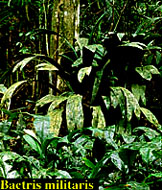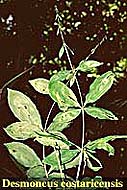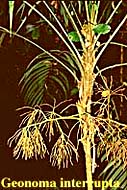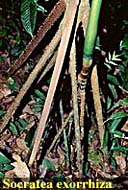 |
QUICK SEARCH
MO PROJECTS:
Africa
Asia/Pacific
Mesoamerica
North America
South America
General Taxonomy
Photo Essays
Training in Latin
America
MO RESEARCH:
Wm. L. Brown Center
Bryology
GIS
Graduate Studies
Research Experiences
for Undergraduates
Imaging Lab
Library
MBG Press
Publications
Climate Change
Catalog Fossil Plants
MO DATABASES:
W³MOST
Image Index
Rare Books
Angiosperm
Phylogeny
Res Botanica
All Databases
INFORMATION:
What's New?
People at MO
Visitor's Guide
Herbarium
Jobs & Fellowships
Symposium
Research Links
Site Map
Search
|
Draft Treatments | Guidelines | Checklist | Citing | Editors    
The Cutting EdgeVolume VI, Number 2, April 1999
News and Notes | Leaps and Bounds | Germane Literature
COURSE TREATMENT. Manual co-PI Barry Hammel took part in a parataxonomist
training course, held during the first two weeks of March in the Refugio
Nacional de Vida Silvestre Gandoca-Manzanillo, in the far southeastern corner
of Costa Rica. This is a botanically intriguing part of the country that
has already yielded numerous country records, but which is still inadequately
inventoried. Also participating in the course were veteran parataxonomists
Reinaldo Aguilar, Evelio Alfaro, Ulises Chavarría,
and Roberto Espinoza, as well as novices Edgar Mora and Allan
Jiménez. Other course instructors included Manual co-PI and INBio
cacique Nelson Zamora, INB curator José González,
and Manual Marantaceae contributor Helen Kennedy (UBC). This course
was designed quite differently from previous ones, in which all parataxonomists
were involved and the theme was basically to collect and identify everything.
This time only botanical parataxonomists took part, and specialization was
the theme, with one goal being the production of a local checklist for a
single family. Arecaceae were chosen, with spectacular results (see under
"Leaps and Bounds"). A simple guide to the palms of the Gandoca
region, illustrated with color photos, was conceived and initiated. During
the course, most of the necessary photos for the planned guide were taken,
and the text was essentially completed. In addition to the group concentration
on palms, each student chose a different family or genus as an individual
project, for which the minimal expectation was a key to the spp. found during
the course. The taxa selected were Anthurium (Araceae), Annonaceae,
Costus (Costaceae), Moraceae, Melastomataceae, and Psychotria
(Rubiaceae). Preliminary keys resulting from the individual projects will
be made available on request. All participants judged the course to be a
resounding success. ANNONACEAE. Collections from the Cordilleras de Guanacaste and Tilarán made by parataxonomist Petrona Ríos and Monteverde guru Bill Haber (respectively) are the first Mesoamerican records for the largely Amazonian Xylopia sericea A. St.-Hil. This material had been confused with the locally better known X. sericophylla Standl. & L. O. Williams, but differs in pubescence color and apocarp form. GERMANE LITERATURE Andersson, L. & J. H. E. Rova. 1999. The rps16 intron and the phylogeny of the Rubioideae (Rubiaceae). Pl. Syst. Evol. 214: 161--186. This study of sequence variation reveals that the vast genus Psychotria "is paraphyletic with respect to all the other genera of the tribe." From the cladogram, we would have said it was polyphyletic. Quite possibly it is both.Backlund, A. & N. Pyck. 1998. Diervillaceae and Linnaeaceae, two new families of caprifolioids. Taxon 47: 657--661. The further breakup of Caprifoliaceae (already shorn of Sambucus and Viburnum) is proposed, mainly (it seems) to obviate the inclusion therein of Dipsacaceae, Morinaceae, and Valerianaceae. But lumping is always preferable to splitting (assuming monophyly), and we have no problem with an enlarged Caprifoliaceae. Better by far than yet more new, little families! Features a phylogenetic tree, brief family descriptions, and a ± natural key to the 12 genera of the three "families" involved.Bernhard, A. & P. K. Endress. 1999. Androecial development and systematics in Flacourtiaceae s. l. Pl. Syst. Evol. 215: 141--155. This study supports recent molecular evidence suggesting a division of the traditional Flacourtiaceae into two smaller families: Flacourtiaceae s. str. (most genera occurring in Costa Rica), and Kiggelariaceae (including Lindackeria, Carpotroche, and Mayna, to name only those genera represented in Costa Rica). Stamens develop centrifugally in the former group, but centripetally, or in "a sequence that is neither distinctly centripetal nor centrifugal," in the latter.Bravo-Hollis, H. & S. Arias. 1999. Sinopsis de la familia Cactaceae en Mesoamérica. Cact. Suc. Mex. 44: 4--19. An informal analysis and evaluation of several regional lists and accounts (including one incarnation of the INBio/Manual data-base), accepting 38 indigenous spp. (plus three infraspecific taxa) for Costa Rica. Of special interest is Apéndice 1, an annotated and nomenclaturally updated (but unvouchered) checklist of Mesoamerican Cactaceae. Our count reveals a surprising total of 16 taxa (13 spp. and three infraspecific taxa) flagged as endemic to Costa Rica. These are: Disocactus kimnachii G. D. Rowley (syn. Nopalxochia horichii Kimnach), Hylocereus calcaratus (F. A. C. Weber) Britton & Rose, Pseudorhipsalis acuminata Cufod., P. himantoclada (Rol.-Goss.) Britton & Rose, P. horichii (Kimnach) Barthlott, P. lankesteri (Kimnach) Barthlott, P. ramulosa (Salm-Dyck) Barthlott var. angustissima (F. A. C. Weber) Barthlott, Rhipsalis micrantha (Kunth) DC. f. micrantha and f. kirbergii (Barthlott) Barthlott, Selenicereus wercklei (F. A. C. Weber) Britton & Rose, Stenocereus aragonii (F. A. C. Weber) Buxb., Weberocereus bradei (Britton & Rose) G. D. Rowley, W. imitans (Kimnach & Hutchison) Buxb., W. tonduzii (F. A. C. Weber) G. D. Rowley, W. trichophorus H. Johnson & Kimnach, and W. tunilla (F. A. C. Weber) Britton & Rose.Chatrou, L. W. 1998. Revision of the Malmea alliance: Malmea and three new, neotropical genera: Klarobelia, Mosannona, and Pseudomalmea. Pp. 103--192 in, L. W. Chatrou, Changing genera: systematic studies in neotropical and West African Annonaceae. Utrecht Univ., Utrecht, Netherlands. This thesis chapter, subtitled "Precursor of Flora Neotropica Monograph," is effectively published here, according to the conditions of the Code (Arts. 29--31), whatever the author's intent. The genus Malmea is divided into four smaller, somewhat technical genera (three newly validated), with no cladistic analysis and no phylogenetic argument of any kind; indeed, the author implies that Malmea s. l. is monophyletic. It would appear that the author has simply managed to recognize some synapomorphies of a few major clades, and has congratulated himself by elevating these to generic rank. The only rationale presented (or alluded to) for this re-ranking is the never-ending quest for genera defined by characters of equal strength: "These groups can be discerned on the basis of several types of morphological and anatomical characters, many of which are significant for generic circumscription within Annonaceae" (emphasis ours). The old table-leg shortening thing. We would argue that the time has passed for this sort of pointless reshuffling: if a traditional genus (or other taxon) is monophyletic, or has not been shown to be otherwise, don't mess with it! Simple as that, a priori. But now, there is the fait accompli factor to be considered: because half (13 of 26) of the spp. in Chatrou's new genera are here described as new, undoing his generic reclassification would wreak as much nomenclatural havoc as adopting it. In view of this, we would have to tentatively endorse the new classification.Jiménez, Q. 1999. Arboles maderables en peligro de extinción en Costa Rica. Ed. II (revisada y ampliada). Inst. Nac. de Biodiversidad, Sto. Domingo de Heredia, Costa Rica. This new edition of Quírico's seminal work spotlights 40 spp. of valuable timber trees threatened and in danger of extinction in Costa Rica. Among these, 18 have already been protected by a ban on cutting, including: Cordia gerascanthus L. (Boraginaceae), Couratari scottmorii Prance (Lecythidaceae), Guaiacum sanctum L. (Zygophyllaceae), Myroxylon balsamum (L.) Harms (Fabaceae: Papilionoideae), and Swietenia macrophylla King (Meliaceae).Kallunki, J. A. & J. R. Pirani. 1998. Synopses of Angostura Roem. & Schult. and Conchocarpus J. C. Mikan (Rutaceae). Kew Bull. 53: 257--334. Angostura is more narrowly defined, as a genus of just seven spp. (as opposed to 38, fide The plant-book). The spp. here newly excluded from Angostura are recognized as members of Conchocarpus, together with some spp. formerly included in other genera such as Galipea and Ticorea. Conchocarpus, not even included in the most recent edition of The plant-book, rises like a phoenix as a genus of 45 spp., strongly centered in eastern Brazil. It seems from the outset a suspicious taxon, described as "quite variable in most characters and...composed of the species that do not fit into the other more easily definable genera." A key is provided to separate Angostura, Conchocarpus, and Galipea, three of the 26 genera in tribe Galipeeae Kallunki subtribe Galipeinae Kallunki (both of the suprageneric names freshly minted to replace their predecessors, based on the illegitimate Cusparia). Twenty-eight new combinations are here validated, plus 24 new infrageneric taxa (none of the latter from Costa Rica). Angostura granulosa (Kallunki) Kallunki comb. nov. (formerly in Galipea), of Nicaragua and Costa Rica, is the only Mesoamerican member of its genus. The sp. most recently known as A. nicaraguensis (Standl. & L. O. Williams) T. S. Elias becomes Conchocarpus nicaraguensis (Standl. & L. O. Williams) Kallunki & Pirani. The only other Conchocarpus sp. reaching Costa Rica is C. guyanensis (Pulle) Kallunki & Pirani, formerly known to us as Ticorea unifoliolata T. S. Elias (see our last issue). Features comprehensive generic descriptions, keys to all spp. in both genera, synonymy and typology, distribution summaries, composite line-drawings of selected (new) taxa, some SEM pollen micrographs, sections on doubtful and excluded species, an index to accepted and rejected names, and an index to exsiccatae. Six lectotypes are designated, as well as one epitype. Absent are sp. descriptions and exsiccatae citations (except for new spp.; these are synopses, after all), and any kind of cladistic or phylogenetic analysis or discussion; the reclassification appears to have been accomplished solely on the basis of character association.Kennedy, H. 1999. Calathea singularis and Stromanthe palustris, two new species of neotropical Marantaceae. Novon 9: 61--65. Only the latter sp. need concern us. The name Stromanthe palustris is here validated for a sp. discovered and recognized as new more than 20 years ago, at the Estación Biológica La Selva. Originally, it was identified as belonging to the genus Ctenanthe, a close relative of Stromanthe; indeed, the classification of the new sp. appears still to be in some doubt. Apart from La Selva, S. palustris is known only from the Reserva Biológica Hitoy-Cerere, south of Puerto Limón. Lengthy description, black-and-white photos of live material.Lewis, G. P. 1998. Caesalpinia: a revision of the Poincianella-Erythrostemon group. The Royal Botanic Gardens, Kew, UK. 233 pp. On the basis of both morphological and cladistic analysis, Caesalpinia (Fabaceae: Caesalpinioideae), a genus of ca. 120--130 spp., has recently been divided by the author and colleagues into various informal "groups." The Poincianella-Erythrostemon "group," here revised, is a strictly New World assemblage of 47 spp., ranging from the southern United States to southern Chile. It is most diverse in drier regions, and not well-represented in southern Central America. Both Caesalpinia eriostachys Benth. and C. exostemma DC., the only spp. reaching Costa Rica, are essentially restricted to the Guanacaste region. Several new taxa and new combinations are validated, but the only one affecting us is C. exostemma subsp. tampicoana (Britton & Rose) G. P. Lewis stat. & comb. nov.; this name, applied to a little-known Mexican taxon, consigns our material to the autonymic subsp. A beautifully presented piece of work that provides nearly all the features one might ask of a taxonomic revision, and then some: a lengthy introductory section, key to spp., thorough descriptions, comprehensive specimen citations, distribution maps, excellent line-drawings, indices to scientific names and exsiccatae, and 15, mostly color, photographic plates, mainly of live plants. There is also a key to the "groups" of Caesalpinia and a detailed, formal description of the Poincianella-Erythrostemon "group"; however, one searches in vain for a concise, diagnostic characterization of the latter.Martínez, M. 1998. Revision of Physalis section Epeteiorhiza (Solanaceae). Anales Inst. Biol. Univ. Nac. Autón. México, Bot. 69: 71--117. Physalis is characterized as a genus of ca. 90 spp., all but one indigenous to the New World. The spp. are tentatively grouped in four subgenera, including subg. Rydbergis Hendrych, characterized by rotate, campanulate, or urceolate, unlobed, mostly maculate corollas. Physalis sect. Epeteiorhiza G. Don, one of nine sections of subg. Rydbergis, is defined by a herbaceous habit, glabrous to pubescent or glandular-pubescent foliage, and solitary flowers with yellow, rotate corollas and terete to strongly 5-angled fruiting calyces. The 14 spp. of sect. Epeteiorhiza range from Canada to South America. Six are recorded from Costa Rica (all wide-ranging, at least in the Mesoamerican region): Physalis cordata Mill., P. ignota Britton, P. minuta Griggs, P. porrecta Waterf., P. pruinosa L., and P. pubescens L. Features introductory sections on taxonomic history and general morphology, descriptions of the genus and section, keys to the subgenera, to sections of subg. Rydbergis, and to spp. of sect. Epeteiorhiza, sp. descriptions, representative specimen citations, range maps, and some line-drawings.Morales, J. F. 1999. A new species of Macoubea (Apocynaceae) from Mesoamerica. Novon 9: 86--88. Macoubea mesoamericana J. F. Morales becomes the third sp. of this mainly Amazonian genus of trees. The only Central American representative, discovered in Costa Rica just 10 years ago (but long known from Panama), has heretofore gone under the name M. sprucei (Müll. Arg.) Markgr. Nonetheless, it differs significantly from the latter in fruit and seed morphology. The Costa Rican collections are all from lowland forests on the Atlantic slope of the Cordillera de Talamanca, while all Panamanian collections have been made along the El Llano--Cartí road. Includes drawings of fruits and seeds of M. mesoamericana and M. sprucei, plus a key to all three spp.Paclt, J. 1999. (1399) Proposal to conserve the name Zizyphus (Rhamnaceae) with that spelling and with feminine gender. Taxon 48: 173--174. According to Art. 62.1 of the Code, "A generic name retains the gender assigned by botanical tradition, irrespective of classical usage or the author's original usage." Paclt's own evidence makes it clear that botanical tradition, classical usage, and the original author's usage converge in assigning feminine gender to this genus. So is it really necessary to propose formal conservation, simply because a minority of workers have gotten it wrong? Paclt's argument for conserving the spelling Zizyphus over Miller's original Ziziphus is also flawed, as noted in Dan Nicolson's editorial aside. We wonder why Taxon even publishes such seemingly needless proposals (only to undermine them with editorial postscripts). Would it help to add an article to the Code fixing spellings and genders of generic names according to Index nominum genericorum, or some other standard work?Reveal, J. L., W. S. Judd & R. Olmstead. 1999. (1405) Proposal to conserve the name Antirrhinaceae against Plantaginaceae (Magnoliophyta). Taxon 48: 182. The sundering of Scrophulariaceae, in the traditional sense, marches on. As we were already aware, "the hemiparasitic herbs historically retained in the Scrophulariaceae are now associated with the wholly parasitic, achlorophyllous Orobanchaceae Vent., so that this family is now defined as a taxon of some 60 genera." These include Agalinis, Buchnera, Castilleja, Euphrasia, Orobanche, and Pedicularis. Scrophulariaceae s. str. is "now restricted to approximately 24 genera," among which are Scrophularia and Verbascum. This leaves nearly 110 genera that do not belong (according to recent molecular/cladistic analyses) in either of the aforementioned families, but comprise a family of their own, for which the oldest available name is Veronicaceae Durande (1782). In addition to Veronica, this family includes Antirrhinum, Linaria, Lindernia, and Penstemon. End of story, but for the fact that "there is considerable evidence" that both Callitrichaceae and Plantaginaceae also belong in Veronicaceae. This would necessitate the use of the name Plantaginaceae Juss. (1789) for the whole group, because it is listed in App. IIB of the Code, while the older Veronicaceae is not. The authors of this proposal, objecting to "the use of [Plantaginaceae] for a taxon dominated by genera traditionally associated with the Scrophulariaceae," at first thought to conserve Veronicaceae, but were thwarted by a provision of the Code that fixes the starting date for conserved family names at 4 Aug. 1789. Thus the present strategy, to conserve Antirrhinaceae Pers. (1806) against Plantaginaceae, in the event the two taxa are united (and if they are not, then Veronicaceae would prevail).Soreng, R. J. & F. R. Barrie. 1999. (1391) Proposal to conserve the name Poa pratensis (Gramineae) with a conserved type. Taxon 48: 157--159. Poa pratensis L., the familiar Kentucky bluegrass (adventive in Costa Rica), is treated by some recent authors as comprising two distinct spp. Turns out that the type does not represent P. pratensis s. str. but, rather, its circumboreal segregate, P. alpigena (Fr. ex Blytt) Lindm. This proposal is of no consequence to workers who continue to treat P. pratensis in the broad sense.Souza, V. C. 1997. Considerações sobre a delimitação de Mecardonia procumbens (Mill.) Small (Scrophulariaceae). Acta Bot. Brasil. 11: 181--189. Five varieties of this weedy herb are recognized, and the appropriate new combinations proposed. Four of the varieties are restricted to southern Brazil and adjacent regions of South America. Costa Rican material would fall into the autonymic variety, widespread from the United States to south Brazil.Steane, D. A., R. W. Scotland, D. J. Mabberley & R. G. Olmstead. 1999. Molecular systematics of Clerodendrum (Lamiaceae): ITS sequences and total evidence. Amer. J. Bot. 86: 98--107. Separate and combined cladistic analyses of ITS sequence and cpDNA restriction-site data all identified four major clades within Clerodendrum s. l., and showed the genus to be polyphyletic. These results support previous studies suggesting that one of these four clades be removed from Clerodendrum s. l. as a separate genus, Rotheca Raf. (see Novon 8: 204--206, 1998), comprising five Old World spp. Furthermore, the oligotypic, North American Tetraclea will have be submerged in Clerodendrum s. str. These changes do not affect any indigenous New World spp. traditionally assigned to Clerodendrum, nor any Old World spp. commonly cultivated in Costa Rica.Tokuoka, T. & H. Tobe. 1999. Embryology of tribe Drypeteae, an enigmatic taxon of Euphorbiaceae. Pl. Syst. Evol. 215: 189--208. "Embryologically Drypeteae do not fit within [Euphorbiaceae subfam.] Phyllanthoideae and, as available nucleotide sequence data from the rbcL gene suggest, are rather placed near Erythroxylaceae, Rhizophoraceae, Chrysobalanaceae, and Linaceae. Drypeteae share with these families a combination of the fibrous exotegmen, the endothelium, and the thick, multiplicative inner integument."Zimmer, B. 1999. Report of the committee for Pteridophyta: 14. Taxon 48: 133--134. Rejection of the obscure Adiantum dissimile Schrad. is recommended, protecting the junior but widely used A. deflectens Mart. [see The Cutting Edge 4(2): 8, Apr. 1997]. Several other rulings are handed down, none of which appears to affect the status quo. |
© 1995-2025 Missouri Botanical Garden, All Rights Reserved
4344 Shaw Blvd.
St. Louis, MO 63110
(314) 577-5100
Technical Support